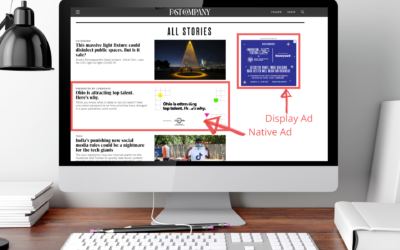Three Steps to Surviving (and Thriving) During and After the Pandemic:
It’s a new day (and future) for all small business owners when it comes to marketing. Right now, there is probably a small business owner sitting at their kitchen table going, “Okay – this is all new to me. Where do I start? What can I do? How can I prepare for the future?”
Believe it or not, the future has been happening for years now, but it’s being thrust into the spotlight: the future of small business marketing is digital. Plain and simple.
However, as a small business owner, until you can wrap your head around the present, how to handle rent, furloughs, layoffs, payroll, bills, etc., it can be difficult to concentrate on what’s next: preparing for re-opening.
That said here are three steps every small business owner can take right now to help ensure they are ready for success tomorrow:
#1 – Take Care of the Here and Now
With all that has happened at the start of 2020, many business owners are confused about where to go for resources, how to take care of staff, etc. Here are some great resources from the U.S. Small Business Association and Government sites that can help:
– Coronavirus (COVID-19): Small Business Guidance & Loan Resources
– Find Your Local Resources / SBA Offices
– Information on the CARES Act & Unemployment Insurance
– Information on the Paycheck Protection Program
These resources are by far not an exhaustive list but can help you to get started with organizing the operational side of your business.
#2 – Review Your Current Digital Marketing Assets
With the ability for people to discover your business offline nearly vanishing for a bit, it is more important than ever to review where your business is digitally. Do you have a website? Do you have social media? Are your current non-digital strategies providing a return on investment?
Review your website (or get one started):
Even if you are a B2B company, having a website is critical to your business being discovered – now and pretty much forever. A common myth is that websites are expensive to build. This myth can be debunked by the numerous out-of-the-box solutions available such as Squarespace and Wix just to name a few. And, if you don’t need a ton of functionality, but want something a bit more robust, a simple WordPress-based site will do just fine.
If budget is an issue (sites do have annual costs of operation such as hosting fees), then look at your bottom line and decide what current marketing effort is no longer being utilized, or just not working, and start there. Re-allocate your budget to provide you a presence online. After all, the cost of domain renewal and hosting is often a tax write-off.
If you can invest in someone building the site, they should work with you to create a site that is focused to your customer base, branded, and works towards creating awareness for your brand and/or product and conversion (getting someone to take an action towards a goal you determine such as a purchase or engagement for business).
Social Media
Myth: You have to be on every single social media platform.
Truth: You should be on the right social media platform for your business. There are many platforms that can be “right” for your business, but we’ll cover the top three:
If you are a B2B company, start a LinkedIn company page. You can find tips on how to create an engaging company page on LinkedIn here. Note: Curating a LinkedIn company page can take time, so don’t get discouraged. Start by sharing articles from other LinkedIn members and online resources that are relevant to your client/customer base.
Myth: Facebook is going away
Truth: Nope.
Facebook is now more than ever a place for people to not only check up on their friends and family but also a great way to gain visibility for your business whether you are a B2B or B2C company.
If you have a Facebook page:
– Review what content you share: Is there one “voice” for your business? Can someone say, “Oh, I know so and so – they are about [enter subject here].”
– Review your information and make sure it’s up to date and accurate.
– Make sure you use one hashtag that your business “owns”
All in all, ensure that your page is professional, informs the viewer about what you do or what you’re selling, and don’t go crazy on hashtags or posts. One to two posts per day is fine for a small business; even 3-4 posts per week will help you stay relevant to your followers.
(There’s so much more here – we’ll follow up with a blog on social media for small business because we can talk all day about this!) For now, here’s a quick 3-minute video from Facebook on how the platform can help your business.
Once you are satisfied with your page, you can explore paid Facebook ad campaigns which are key to getting the right customer to engage. Find more on advertising on Facebook here.
Instagram:
Instagram is essential for B2C companies. B2B businesses can sometimes benefit, but the platform is tailored to selling a product or service to consumers.
Set up an Instagram business profile, make sure it reflects your business’ brand, and post a couple of times a week.
Tip: The most engaging content is video, but nice photos will work, too. Hashtags are a “thing” on Instagram, so feel free to go crazy here with hashtags that are relevant to your post or business.
For more advanced users, check out advertising on Instagram and be sure to comment as the “first comment” with hashtags relevant to the post and your business. Advertising is done through Facebook, so review the advertising section above for information on how the two platforms work together to deliver ads.
YouTube
Video, video, video…this used to be the way of the future. Well, it’s now the “here and now.” If you haven’t noticed, we’ve been thrust into a video “revolution” of sorts with people working from home over video calls, staying in touch with friends and family through video conferencing and Facetime, Hangouts, Duo, etc.
So, how can you get your business in on the action? Use this time to set up a YouTube channel and start creating short videos (three minutes is great).
Not every video you create will be a smash hit, but starting small can reap rewards in the long run. B2B and B2C companies large and small can use video to showcase products, provide tips and “how-to” videos, and even show how your business runs or a product is made. Behind-the-scenes interviews are great as they give people a more authentic and personal look into your business that you may not be able to otherwise convey online.

For example, if you have a brick and mortar location that people can’t physically get to, consider shooting a video about your product, or highlight some key employees through videos that showcase what people can experience when they can visit.
And as another example, we have a client who is going to begin a video series on common golf swing myths debunked. Followers on social media will submit their questions, and the owners of the golf club fitting business will debunk the myth using props (golf clubs) and video explanations. The client is creating an inspirational experience that will hopefully turn the viewers into customers once they can visit the shop again.
Don’t get discouraged if you are not a video editor. There are many tools such as iMovie where you can just use your phone to record a quick video.
#3 – Review Current Marketing Efforts to Help Plan for the Future
There’s no better way to use the time now than to review how your business is currently targeting and spending money on marketing.
Review trends from past years
Take this time to look at trends and patterns from years past. Are there certain times of the year that are better for revenue than others? Most likely, the answer is ‘yes.’
Optimize your budget
Optimize your marketing spend to flow throughout the year. Do you really need to advertise in a magazine every month (if at all)? Whatever the spend, make sure it’s working as hard as possible for your business by targeting key months or the months leading up to big spending.
If you notice that a certain area of spend isn’t performing, why not try reallocating that spend into digital? Now that you have a website and social media set up, using Google ads to drive traffic to your sites is a great way to drive visitors to your website.
Curate your messaging to drive sales during key periods
Look at certain times of the year in “themes.” Like most businesses, there will be better times of the year for sales. Ensure that you create messaging on your social media and offers for clients and customers that help to drive sales for those times of the year.
For example, if you notice that during a certain month your product is in demand more than at other times of the year, make sure that marketing efforts leading up to that period of increase are geared towards one “theme.”
A few questions to ask yourself are:
– What are my clients/customers interested in during certain months?
– What do I sell most of and when?
– What things are going on during that time of the year that could influence or hurt sales?
After all, you wouldn’t want to spend your limited marketing budget pushing to sell a product during a time of the year when there’s no demand.
Awareness -> Intent -> Conversion
Taking the above into account, look at your marketing plan (even if it’s just a sheet of paper with ideas!) and make sure you’re hitting your target audience at the right times by:
– Creating awareness during the times of the year when sales or contracts are slow so you stay top-of-mind. Show your target audience who you are and what you have to offer.
– Creating an intent-to-buy or intent-to-engage in the months leading up to periods of increased sales by showing them what they are missing out on. Basically, why does the consumer or client need your product or service? Is there an offer you can promote that drives sales early based on any patterns you’ve identified?
– Capitalize on converting the consumer from needing your product or service to purchasing or engaging during key times of the year.
If you’ve stayed top of mind during slower months, and shown the “need” during the ramp-up period, then when it’s time for the consumer or client to pull the trigger, you will be the first one they think of.
Final Thoughts:
Times are uncertain right now – this is true for everyone. However, if as a business owner you can get through the first step of organizing your operations, it will be easier to sit down and formulate a plan to come back bigger and better using the power and flexibility of digital marketing.
The beauty of digital marketing is that it is flexible. If you come up with a plan and need to change course quickly, you can reallocate your budget much more easily to flow the spend in new or different areas and also change targeting and tactics relatively quickly.
Ensuring your business is well represented online in the right way is step one (after taking care of the housekeeping). Then, you can experiment with different modes of advertising, messaging, etc. and see what digital tactics work best for your business.
Don’t be discouraged, either. It will usually take about three months for a digital campaign to reap rewards or show signs that you should change course. Course correction is also common as we cannot predict the future.
Stay open-minded, well-informed, and see change as an opportunity to grow your business in ways you may have never even thought were possible before.
Other Resources
5 Steps to Create an Outstanding Marketing Plan [Free Templates]









0 Comments